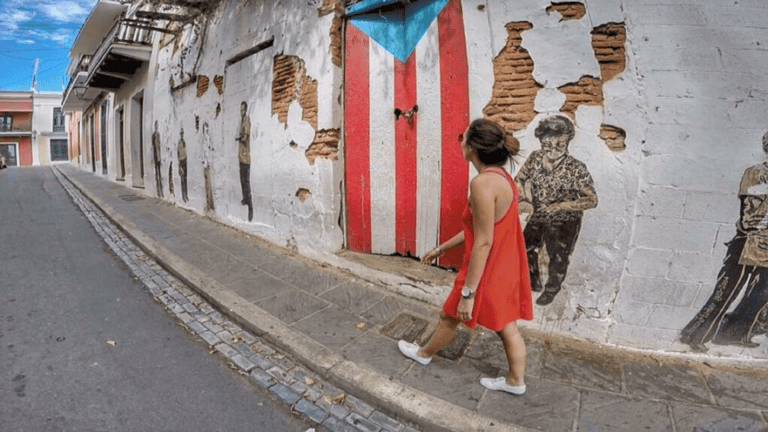How To Get Around In Puerto Rico
Trying to figure out how to get around in Puerto Rico? You’re not alone.

If you’re planning to explore beaches, wander through Old San Juan, or take a day trip to El Yunque or the West Coast, knowing your transportation options in Puerto Rico is key to making the most of your trip.
As locals who live here and regularly help friends and family navigate the island, we’ve pulled together everything you need to know.
From renting a car to using Uber, taking the train, or booking private tours.
We’ll walk you through what’s worth your time, what to skip, and how to travel like someone who actually knows the island.
Getting Around In Puerto Rico
Renting a Car in Puerto Rico

Where to Rent a Car
If freedom and flexibility are what you’re after, renting a car is one of the best ways to get around in Puerto Rico.
The majority of rental companies are located at Luis Muñoz Marín International Airport (SJU) or in nearby Isla Verde.
You’ll find major names like Enterprise, Hertz, and Budget, but also local options like Charlie Car Rental, which often offers great rates and reliable service.
If you’re not renting at the airport, there are pick-up locations in Condado, Carolina, and even in towns like Ponce or Mayagüez.
Just double-check their hours and availability.
Rental Costs, Gas Prices, and Insurance
Expect to pay between $30 and $70 per day, depending on the vehicle type, insurance coverage, and season (high season runs from December through April).
Compact cars are usually the cheapest option, but if you’re heading to the mountains or beaches with friends, consider something roomier or with 4WD.
Tip
Gas in Puerto Rico is sold by the liter, not the gallon like in mainland U.S.
As of 2025, gas prices in Puerto Rico range from about $0.75 to $0.95 per liter, depending on whether you’re filling up with regular or premium. That’s roughly $2.85 to $3.60 per gallon.
On average, we spend about $35 to $40 a week to fill up our SUV with regular gas, which typically costs around $0.75 USD per liter.
Remember to always return the car with a full tank; gas stations are everywhere, and most accept credit cards.
Insurance can add another $10–$25 per day, especially if you don’t have a credit card that covers rentals.
Road Conditions and GPS Navigation
Driving in Puerto Rico can feel familiar to mainland Americans.
We drive on the right-hand side, and the road signs are mostly in both English and Spanish.
However, roads in rural areas can be narrow, bumpy, or poorly lit, so drive cautiously, especially at night.
Google Maps and Waze both work well in Puerto Rico.
Waze is especially popular among locals because it updates real-time traffic and police stops faster.
Just download offline maps if you’re heading into remote areas.
Tips for Driving in Puerto Rico
Driving here can be stressful and chaotic at times. Yes, even for us locals.
Drivers can be aggressive, turn signals are optional (kidding, kind of), and merging is often a game of nerves.
Defensive driving is key, and you’ll want to stay calm, especially in city traffic.
Be mindful of toll roads, especially PR-52 and PR-22.
Rental cars usually come with an AutoExpreso tag, but always ask when you pick up your vehicle.
Tolls range from $0.75 to $3.00, depending on the route.
Also, don’t rely solely on addresses. Many homes and businesses don’t use street numbers the way the mainland does.
That’s where Google Maps comes in handy, it’ll guide you right to the exact location or building.
Public Transportation in Puerto Rico
Taxis
Taxis are available at the airport, in hotel zones, and in big towns like San Juan or Ponce.
You can also hire a taxi for the day, which is a great option for sightseeing without driving. Just be sure to negotiate the price and hours upfront.
Regular fares vary: getting from the airport to Old San Juan might cost $25–$35, and day hires range between $100–$200, depending on distance and wait time.
We rarely use taxis, but when we do, it’s usually just to get home from the airport, especially back when Uber wasn’t available on the island.
The service is reliable and the taxi drivers are friendly, but prices can be high depending on the route.
Uber
Uber is widely available in the San Juan metro area. From the airport to Condado, Isla Verde, and even parts of Bayamón and Carolina.
It’s often cheaper than taxis, with rides around town averaging $5–$15 depending on distance and time of day.
Uber is great if you are staying in the metro area and want to go from Condado or Isla Verde to Old San Juan.
Tip
Uber pickups are allowed at the airport, but you’ll need to head to the first floor of Terminal A if you arrive by Jet Blue. If you arrive by any other airline head to the arrivals area of Terminal D, between columns 16-20.
Tren Urbano
San Juan’s Tren Urbano (Urban Train) runs from Bayamón to Santurce and is handy for commuting along this route.
A one-way fare is $1.50, and the trains are clean, air-conditioned, and safe.
That said, the train isn’t always reliable, delays happen, and stations don’t cover many tourist areas.
We love taking the train when it makes sense, it’s clean, affordable, and easy to use.
The downside is that it doesn’t reach many areas, and once you get off, you’ll usually still need a car to get around.
Unfortunately, outside of walkable spots like Old San Juan, Condado, and Isla Verde, most of Puerto Rico isn’t designed for getting around on foot.
Buses (AMA System)
The AMA public bus system is another budget option at just $0.75 per ride, but like the train, it comes with a catch: it’s not very reliable or punctual.
Buses can be delayed, especially outside of rush hours, and routes can be confusing for newcomers.
If you have time and patience, buses can work for short hops within San Juan.
But for cross-island trips or beach days, these are not an option.
Electric Scooters
Electric scooters are becoming a popular way to get around some of Puerto Rico’s busiest neighborhoods, especially in San Juan, Condado, Santurce, and Miramar.
They’re great for short rides to the beach, local cafés, or just exploring the city without having to worry about traffic or parking.
These scooters are lightweight, easy to use, and an alternative if you’re staying in the metro area.
To rent one, all you need is a smartphone.
Several companies operate in Puerto Rico, including Skootel, Bird, and Lime, depending on the area.
Most scooters cost about $1 to unlock and $0.25–$0.35 per minute after that.
You’ll find them parked on sidewalks and near popular spots, just open the app, scan the QR code, and you’re ready to ride.
While they’re super convenient, electric scooters aren’t allowed on highways or major roads.
Stick to bike lanes or quieter streets, and avoid riding on sidewalks.
Private Transportation in Puerto Rico
Private transport is a nice middle ground between Uber and car rentals.
Many local companies and drivers offer chauffeured services with modern vans or SUVs.
These are especially popular for weddings, business travel, or day tours with friends or family.
You can book hourly or point-to-point rides.
Expect to pay around $60–$100 per hour for a private driver with a van, and a bit more for luxury options.
Many of these services include bilingual drivers and local insights you won’t get from an app.
Hotels can arrange these rides, or you can book online through local companies or tour platforms.
Organized Day Tours and Excursions
If you don’t want to navigate traffic yourself? You can let someone else handle the driving!
Organized day tours are one of the easiest ways to explore Puerto Rico’s top spots.
You’ll find group and private tours to places like:
- El Yunque Rainforest
- Culebra and Vieques beaches
- Camuy Caves and Arecibo Observatory
- Old San Juan and Piñones
Prices start at around $50 per person for group tours and go up to $150+ for more exclusive or full-day options.
Most include round-trip transportation, a guide, and sometimes meals or gear.
Booking platforms like Viator, GetYourGuide, or even your hotel concierge can help you find solid, licensed providers.
How to Get to Culebra or Vieques

Culebra and Vieques are two of Puerto Rico’s most beautiful islands, known for their turquoise water, laid-back vibe, and beaches like Flamenco and Sun Bay.
But because they’re located off the east coast, getting there takes a little planning.
You have two main options: take the ferry from Ceiba or hop on a small plane.
Both are great in their own way, it just depends on your budget, time, and comfort level.
By Ferry
The most affordable way to reach either island is by ferry from the Ceiba ferry terminal, located about 1 to 1.5 hours from San Juan by car.
Ferries run daily to both Culebra and Vieques, and the service is run by the Puerto Rico Maritime Transport Authority.
Tickets cost about $2.25 to $2.50 per person each way, making it a great budget choice.
Travel time is around 45 minutes to Culebra and about 30 minutes to Vieques.
That said, the ferry isn’t always the most reliable.
It’s important to book ahead on www.puertoricoferry.com, especially on weekends or holidays when locals head to the islands too.
Arrive at least 45 minutes early, and bring snacks and patience.
Seating is basic, and delays can happen, but if you’re not in a rush, it’s a great way to travel like a local and enjoy the ocean views.
BY PLANE
If you’re short on time or just prefer a quicker, more comfortable trip, flying is the way to go.
Local airlines like Cape Air, Vieques Air Link, and Air Flamenco offer daily flights to both islands.
From San Juan’s Isla Grande Airport, flights take about 30 minutes, while flights from the smaller Ceiba airport take as little as 10 to 15 minutes.
Prices for flights range from $75 to $120 each way, depending on the airline and season.
It’s more expensive than the ferry, but you’ll save a ton of time, especially if you’re doing a day trip.
Just keep in mind that small planes have strict luggage limits, so check your baggage allowance in advance and pack light.
What’s the Best Way to Get Around in Puerto Rico?
The truth is, getting around in Puerto Rico depends on your travel style.
If you want flexibility and plan to visit the mountains or beaches, rent a car.
If you’re sticking to the metro area, Uber or taxis are easy and affordable.
And if you want to just relax, book a day tour and enjoy the ride.
Locals like us mostly drive our cars, but we like to use Uber when coming home from a trip.
We also enjoy taking a ride on the “Tren Urbano” when visiting museums in Bayamón, where the parking is limited.
Want insider guides, hidden gems, and local tips from people who live and love Puerto Rico?
Subscribe to our newsletter and get the island’s best-kept secrets delivered straight to your inbox.





